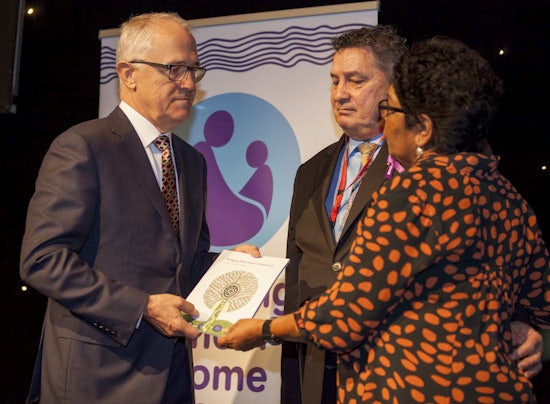Better strategies needed to support ageing Stolen Generation survivors in care
Despite the country stopping to recognise National Reconciliation Week last week, it seems there is much that needs to be done to help ageing survivors of the Stolen Generations as they enter the aged care sector.

The Healing Foundation’s Stolen Generations Reference Committee Chair Florence Onus and Board Chair Steve Larkin present the report to Prime Minister Malcolm Turnbull (Source: The Healing Foundation)
This year’s National Sorry Day, May 26, marked the 20th anniversary of the Bringing Them Home Report. To honour this significant anniversary and draw attention to the lack of progress made in rectifying the damage done to Aboriginal and Torres Strait Islander people since 1997, the Healing Foundation launched its Action Plan – Bringing Them Home 20 Years On: an Action Plan for Healing – in the Federal Parliament.
The Bringing Them Home 20 Years On: an Action Plan for Healing document reveals that a minimum of one in 10 Aboriginal and Torres Strait Islander people were forcibly removed from their families and communities between 1905 and 1970. It also estimates that the current number of Stolen Generation survivors is now around 15,000, many of them ageing and in need of better aged care services.
Tiffany McComsey is the Chief Executive Officer of the Kinchela Boys Home Aboriginal Corporation in the Sydney suburb of Redfern, which supports Stolen Generations survivors of the former Kinchela Aboriginal Boys Training Home. She says that one of the biggest issues for ageing Stolen Generations survivors is the fear of being re-institutionalised and the reliving of trauma because of their childhood experiences in institutional care.
“If you imagine that there were many children who were abused in institutions – that’s physical, emotional, psychological, sexual and cultural abuse – the fear of having to go into residential care at that late stage of their life could trigger all of those memories, some of which have long been blocked out,” Dr McComsey says.
“Ageing Stolen Generation survivors are also unlikely to identify problems that they might have when being assessed for home care support, so they may end up receiving packages that aren’t actually meeting their needs.
“Social isolation is also a huge factor for survivors who feel they live between the Aboriginal and white communities and don’t belong in either. Because of their removal as children, they don’t have the extended family and kinship networks that other Aboriginal people do, so they feel that isolation even more and may rely on the potentially poor care support they might receive.”
Dr McComsey says there also needs to be a review of the packages and resources allocated to Stolen Generation survivors, who unfortunately have lower socio-economic and educational outcomes than the Aboriginal and Torres Strait Islander population as a whole and require greater assistance.
Paulette Whitton, Aboriginal Liaison Officer for aged care service provider Annecto, says one of the biggest issues for older Aboriginal and Torres Strait Islander people, not just Stolen Generations survivors, is that residential aged care homes are not part of the culture.
“We have traditionally looked after our own in the home, but there is an increasing need in this modern day and age for these facilities,” she says.
“Aboriginal people aren’t aware a lot of the time of home care packages, or they have heard about them but they don’t know how to access them. They don’t know how to get through the system, there is a lot of confusion and when it is all too hard they’re not even going to bother.”
Ms Whitton says one way to better support Aboriginal and Torres Strait Islander people in aged care would be to develop more facilities that cater specifically to their needs.
“We have the highest Aboriginal population in the country in Western Sydney, yet we don’t have any sort of nursing or retirement facilities for our people, staffed by our people and with our culture in mind,” she says.
“At the moment we have a couple of Uncles who went through the Kinchela Boys Home who are living in nursing homes together – if they were there by themselves, they would even feel more alone than what they would if they were in a residential facility with other Stolen Generations survivors and Aboriginal people around them.
“Nobody understands Aboriginal people and what they’ve gone through like other Aboriginal people.”
Both Dr McComsey and Ms Whitton say they want to see the government develop a strategy for dealing with Stolen Generation survivors within the aged care sector, to better address their specific needs.
“We can’t wait another 20 years,” says Dr McComesy.
“More elders are passing away, which also triggers those past traumas, because for the other survivors it feels like they’re losing family. If the Government waits too long, it is going to hurt more families and the intergenerational trauma is only going to compound itself.
“We need culturally safe practices for those working in the aged care sector implemented across the board because its not just about being culturally appropriate, its about actually working in a culturally safe way and that requires non-Aboriginal and Torres Strait Islander organisations in particular to invest in organisations that will ensure they are being culturally safe.
“Also, there needs to be an understanding that every Aboriginal and Torres Strait Islander community has its own unique history and legacies that need to be respected, and protocols that need to be understood by those working with those people.”
More information and resources for Aboriginal and Torres Strait Islander people can be found at The Healing Foundation website, along with a full copy of the Bringing Them Home 20 Years On: an action plan for healing report.























